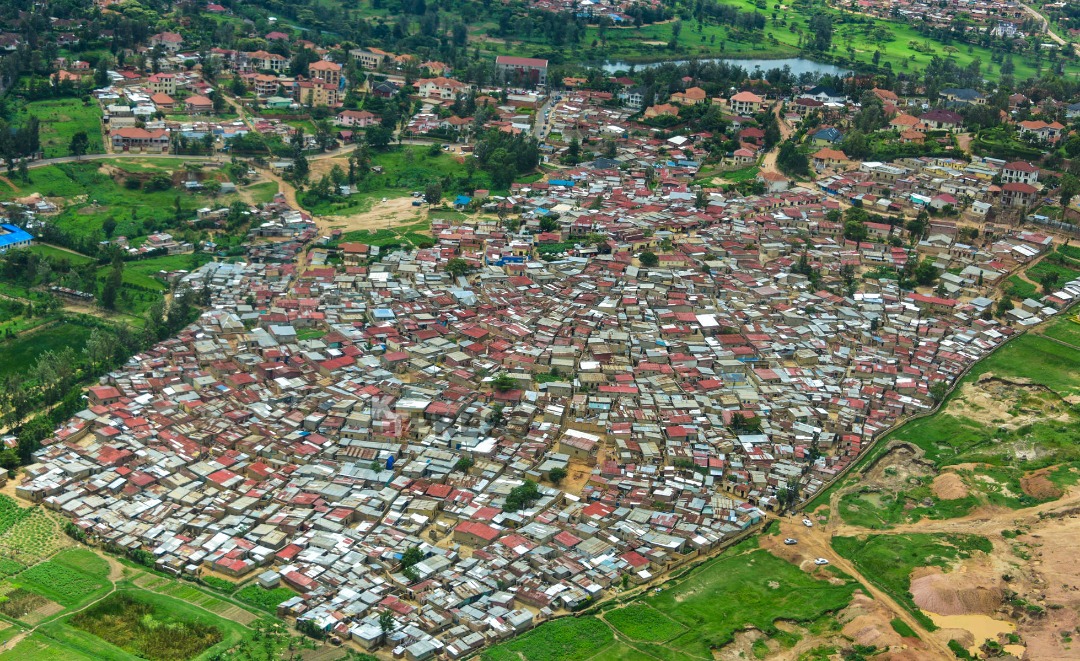
The Kangondo settlement commonly known as Bannyahe
Over 1000 embattled Kigali residents living in the disputed Kangondo and Kibiraro – a slum adjacent to Kigali’s posh residential areas of Nyarutarama and Kibagabaga in Remera sector, Gasabo district, have threatened to further push their appeal to the Local Government Ministry, to seek rights to repossess their land.
The residents say that after a failed expropriation deal, they want the government to grant them rights to their land or else return to a court battle over the same issue.
In 2018, Bannyahe residents entered a court case to resolve a bitter disagreement with Gasabo district, over the land which had been designated for developmental activities, but both sides could not agree on the terms.
Gasabo district had proposed expropriating the residents to new houses in Busanza estates, in Kicukiro district but a break-away group of the majority of residents contended to be expropriated in monetary terms, while other residents involved bought the idea.
After months of a court battle inside Gasabo Intermediate Court, in Rusororo sector, the break-away group lost the case in November 2018, on grounds that they had not followed the right procedures in submitting their plea to the rightful authorities.
To this effect, the City of Kigali (CoK), last month, announced that Bannyahe residents will be relocated starting next month, commencing with the first batch of over 360 residents.
In the wake of this announcement, the break-way group led by Jean de Dieu Shikama ignited a second controversial threat to return to court again but this time correcting the previous procedural errors made in the first case.
As provided in the legal procedure, the team says it has written to Gasabo district and the city of Kigali informing them of their new plans.
The said letters sent to City of Kigali, which KT Press had access to, asked that “Since the expropriation, period expired we are demanding a 5% payment fine on delays and rights to repossess of our land”.
The expropriation law provides that payments should be made after three months of valuation of the expropriated land, and any delay calls for a 5% fine on the valued cost.
According to Shikama, each of the affected residents wrote separately but similar content in their letters were addressed to the city of Kigali.
The letter was written and deposited last month soon after city authorities announced plans to relocate Bannyahe residents on the previous terms, citing environmental issues in the slums.
“We have not heard any response from the city authorities, and we now plan to write to Minaloc (this Tuesday). If this fails then the last step to resort to, will be going back to court,” Shikama said in a phone interview.
In response, City of Kigali Mayor Pudence Rubingisa said that he is not aware of the letters written. He, however, added that city authorities are willing to resolve this dispute and have been meeting the concerned persons.
“We have been open to meet with special cases, because we didn’t want to have a general case and this means individual cases can be addressed,” Mayor Rubingisa told KT Press.
Some of the special cases, in this matter, include those who live in the wetlands, seeking property re-valuation which goes through the district and city authorities, according to Rubingisa.
In the meantime, the new proposed housing project developed by Savannah Creek Development Company, meant to accommodate 1200 Bannyahe residents’ families has reached over 20%, but only 79 of the homeowners who visited the site, agreed to the proposition of moving to the new area.
Most of the residents of Bannyahe shifted to the area over 10 years ago after being expropriated from the former Kiyovu in the Heart of the capital Kigali.
Slowly and over time, residents profited the loopholes in the land administrative systems and laws to invest in constructing brick and tile houses while others built shanty homes.

